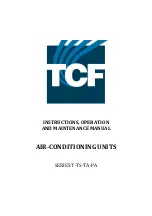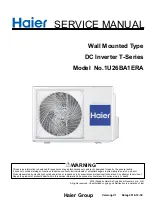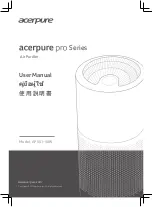
8
GB
Center of gravity and Product Weight
5. Installing the unit
5.1. Hanging the unit body
s
s
s
s
s
Bring the indoor unit to an installation site as it is packed.
s
s
s
s
s
To hang the indoor unit, use a lifting machine to lift and pass through the
hanging bolts.
s
s
s
s
s
When lifting with a lifting machine, in order to protect against damage,
reverse the unit body as is packed with the packing cap and lift it.
3.1. Securing installation and service space
[Fig. 3.1.1] (P.2)
•
Select a blowout direction suited for room shape, installation site and so on.
•
Piping, wiring and maintenance are all done on the bottom and the side. So,
secure the space given below for such work. Also, taking into consideration
serviceability and safety in hanging, secure as large space as possible.
4. Fixing hanging bolts
4.2. Ceiling hole and hanging bolt positions
•
Use the gauge supplied with the panel to fix hanging bolts so that the unit body
and ceiling hole are positioned in place as shown in [Fig. 4.2.1]. For how to use
the gauge, refer to the instruction manual supplied with the panel.
Notes:
•
The gauge may expand or shrink with changes in the temperature and
humidity. First be sure to check the product dimensions, and then use
the gauge.
•
The ceiling hole is adjustable as shown in [Fig. 4.2.1]. Align the centers
of both ceiling hole and unit body so that the unit body is not biased to
the ceiling hole and that the gaps between the ceiling hole edges and the
unit body’s external dimensions come to be identical.
•
Use M10 hanging bolts (for all bolts). (field supply)
•
Each hanging bolt must extrude C mm from the ceiling. It is possible to slide
the unit body 10 mm max. within part of the heights of the unit body and deco-
rative panel in order to make fine installation adjustments to the finished ceil-
ing surface. Sliding the unit body and incorporating a high-performance filter
requires the dimensions given in [Fig. 4.2.1]. To this, attach nuts which will fix
a hanging bracket as shown in [Fig. 4.2.1].
[Fig. 4.2.1] (P.3)
A
Nut
B
Washer (supplied with the unit body)
C
Hanging bolt ø10 (M10 screw)
D
Ceiling hole dimensions
E
Hanging bolt pitch
F
Hanging bolt
G
Finished ceiling surface
H
Hanging bracket
Note:
•
Affixed on the back surface of each split flow duct end connection is
insulating material. Use a cutter knife to cut the insulating material along
the end connection.
3.3. Outdoor air inlet
[Fig. 3.3.1] (P.2)
A
Fresh air intake
B
Fresh air intake
240 mm
×
45 mm knock out hole
C
Fresh air intake
ø150 knock out hole
D
4-ø2.9 mounting hole
E
Cut
Notes:
1
1
1
1
1
Make 4 cuts on the outdoor air inlet. When connecting a round flexible
duct, mount an optional outdoor air intake duct flange PAC-KH 110F (ø150).
2
2
2
2
2
The amount of suction air coming through the outdoor air inlet can be
adjusted by making two cuts on the outdoor air inlet as shown in
[Fig. 3.3.1].
3.4. Combining indoor units with outdoor
units
For combining indoor units with outdoor units, refer to the outdoor unit installation
manual.
3.2. Split flow duct end connection - fresh
air intake
[Fig. 3.2.1] (P.2)
•
Knockouts are provided at each position as shown in the figure. Use them for
your purposes when installing the unit.
A
Split flow duct end connection
B
Split flow duct end connection (435 mm
×
110 mm knock out on both sides)
C
Split flow duct end connection (754 mm
×
110 mm knock out on both sides)
D
Split flow duct end connection (ø200 knock out on both sides)
E
10-ø2.9 mounting hole
F
6-ø2.9 mounting hole
G
4-ø2.9 mounting hole
4.1. Fixing hanging bolts
(Give site of suspension strong structure.)
Hanging structure
•
Ceiling: The ceiling structure varies from building to one another. For detailed
information, consult your construction company.
•
If necessary, reinforce the hanging bolts with anti-quake supporting members
as countermeasures against earthquakes.
* Use M10 for hanging bolts and anti-quake supporting members (field supply).
1
Reinforcing the ceiling with additional members (edge beam, etc.) must be
required to keep the ceiling at level and to prevent the ceiling from vibrations.
2
Cut and remove the ceiling members.
3
Reinforce the ceiling members, and add other members for fixing the ceiling
boards.
[Fig. 4.1.1] (P.2)
A
Center of gravity
Model name
20-40
50 · 63
80 · 100
125
A
1080
1250
1750
2010
B
More than 1000
C
More than 500
D
Lap: 20
E
More than 350
Model name
PLFY-P20VLMD-E
PLFY-P25VLMD-E
PLFY-P32VLMD-E
PLFY-P40VLMD-E
PLFY-P50VLMD-E
PLFY-P63VLMD-E
PLFY-P80VLMD-E
PLFY-P100VLMD-E
PLFY-P125VLMD-E
574
574
574
574
574
574
574
574
574
824
824
824
824
994
994
1494
1494
1756
172
172
172
172
172
172
172
172
203
287
287
287
287
287
287
287
287
287
370
370
370
370
445
445
655
655
758
160
160
160
160
160
160
160
160
181
23
23
24
24
27
28
44
47
56
6.5
6.5
6.5
6.5
7.5
7.5
12.5
12.5
13
W
(mm)
L
(mm)
H
(mm)
X
(mm)
Y
(mm)
Z
(mm)
Unit
Weight
(kg)
Panel
Weight
(kg)
Model name
20 – 40
50 · 63
80 · 100
125
A
1040
1210
1710
1970
B
824
994
1494
1756
C
157 – 167
155 – 165
D
More than 350
[Fig. 5.1.1] (P.3)
A
Drain pipe side
B
Unit body
C
Packing cap
D
Lifting machine
(Unit: mm)
(Unit: mm)









































